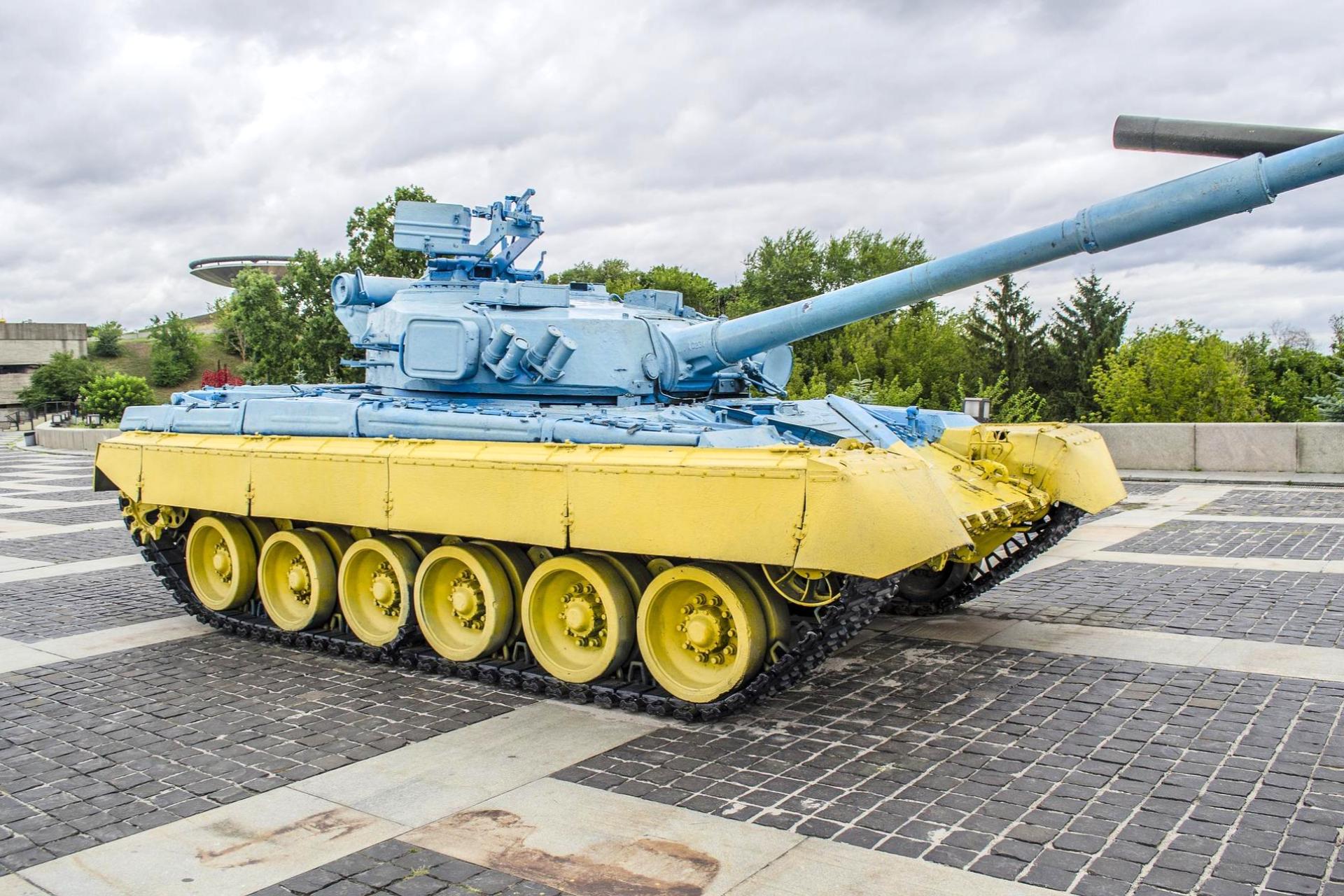The images on the laptop are of a ghost town. The camera looking down, swivels and zooms in on a burnt-out school. Sitting in the back of a Ukrainian military van, hidden under camouflage netting, Sacha monitors video from a surveillance drone.
His team just launched the drone off a 30-foot-long slingshot. It’s now crossed the front line and peered into a Russian-occupied village.
Sacha zooms in further. “You see the burned machines,” he says, pointing to a pair of rust-red metal carcasses in the school yard. A turret comes into view as the drone, flying nearly one kilometer above the village, crosses over the school. “That’s a burned tank,” Sacha says.
No cars are moving in the streets. No pedestrians. It appears to Sacha that all the residents of the village have fled. Various animals wander from yard to yard.
“You can see the cows,” he says, pointing at the screen. “They don’t belong to anyone anymore. Unfortunately, animals also suffer in this war.”
Sacha and one of his drone team colleagues monitor a live video feed from a drone they’re flying over a Russian-occupied part of Ukraine.
Their job for the day is to determine whether Russian forces have pulled back entirely from this village. The area is contested, and the Ukrainians have recently shelled it heavily with artillery. “We got this task from intelligence this morning,” Sacha says, referring to the Ukrainian military intelligence service.
The resolution of the live-streamed video is good enough that Sacha says he can recognise stray dogs by sight in many of the villages he monitors. The drone stores even higher-resolution images in an on-board memory chip that his team can analyse more closely once the drone returns.
“The day before yesterday, the enemy truck was in the yard there,” Sacha says, leaning closer to the laptop. “Now the truck is gone.”
The unit is named for a popular fictional character
This Ukrainian drone unit is named Karlson after a flying character from a classic Swedish children’s book, Karlsson on the Roof.
They’ve allowed NPR to visit them under the condition that their full names and location are not disclosed.
The team uses various small drones that you can buy at an electronics store for a few thousand dollars. On this day, they’re operating their largest fixed-wing drone. They raised tens of thousands of dollars to purchase this online. It looks like a miniature plane, with a camera mounted on its nose.
The Karlson aerial surveillance team is officially a territorial defense unit. In Ukraine, just about anybody can set up a territorial defense unit. Some of them are simply a bunch of guys with AK-47s who take turns manning checkpoints outside villages. Others are fully equipped infantry units that have been incorporated into the armed forces.
Karlson is made up of 23 men, mostly in their 30s, from the Dnipro area. Prior to the Russian invasion, none had military experience. The commander, who goes by the nom de guerre “Playboy,” says everyone on the team has different backgrounds. Playboy used to run his own business.
“We have technical specialists, IT specialists,” he says.
Sacha, in his fatigues, body armor and beard, looks every bit the soldier. Playboy says with a laugh, “Can you believe he used to be a politician!”
Sacha quickly corrects him: “Deputy. I was a deputy.”
Drone surveillance supports what its commander calls the “fist of war”
The conflict in Ukraine is predominantly an artillery war. Both sides are shelling each other’s positions across a front line that stretches for hundreds of miles along eastern and southern Ukraine. Playboy calls artillery the “fist of war.” He says he and his colleagues set up this drone surveillance unit to help that fist punch more accurately.
A spokesperson for the Armed Forces of Ukraine declined to comment on how many drone units like this one the country has. She says they won’t comment on military operations. But outside observers say in this conflict, thousands of drones are being used by both sides.
Along most of the front lines, cellphone and GPS signals are being jammed and monitored by both the Russians and the Ukrainians. To communicate, the Karlson team uses handheld walkie-talkies and a mobile Starlink connection donated by Elon Musk’s satellite-based internet company. If they spot a potential target, they use the Starlink connection to call other military units.
“Sometimes if we see a [Russian] convoy, we are in touch with the artillery unit,” Sacha says. “We give them the coordinates and they start shelling.”
An aerial game of spy vs. spy
In the city of Zaporizhzhia, Denis Pasko, who is not part of the Karlson unit, runs a drone school. He trains Ukrainian soldiers on using them both for surveillance and, in his words, to “drop explosives on the Russians heads.”
Pasko says drones can be incredibly useful to a military unit. They can relatively safely and quickly give soldiers a view of the battlefield. But he warns that commercial drones are incredibly easy to track and often expose information about the location of the operator.
Sacha, from the Karlson team, gets ready to launch a surveillance drone in southern Ukraine. Both the Ukrainians and the Russians are using drones to try to gain an advantage in the conflict.
Jason Beaubien/NPR
“You need to be close to the front lines,” he says. “And if the enemy knows your position, you can be dead.”
When a drone is “lost” in combat, Pasko says it’s usually not shot down. Usually the enemy managed to commandeer control of its navigation system. If a drone is caught by the enemy, Pasko says, it can give away a lot of information.
“It has the geo-position of the operator. It keeps a history of all the places where it was flying,” he says, “including the exact location of where it was launched. The enemy can immediately target the drone team with a missile or mortar shells.”
The spot where the Karlson team is working on this day is a cluster of trees separating a recently harvested wheat field from a long patch of sunflowers. Next to the van where Sasha and his colleagues monitor the drone, there are coffin-sized pits that the team can dive into if the Russians start shelling their mobile base.
In addition to surveillance, the unit is also trying to track and intercept Russian drones — while, on the other side of the front line, Russian drone operators are hunting for Karlson’s drones. It’s an aerial game of spy vs. spy.
On many days, the work can involve hours of staring at video footage. Searching. Looking for clues.
“This is our task,” Sacha says. “We sit the whole day and watch.”
Amidst the animals and deserted houses on the laptop, he spots what could be a dug-in Russian tank. A trampoline-size patch of dirt looks like it was recently dug up and then smoothed over. Sasha makes a note of its position. He says he’ll look at the location more closely on the high-definition images when the drone returns.
Shelling can be heard in the distance. Sasha doesn’t so much as look up from his screen.
“Outgoing,” he mutters.
He says it’s nothing to worry about. Their drone keeps scanning across the front line. And presumably, somewhere in the sky nearby, Russian drones are also scanning the landscape — looking for Karlson’s mobile base among the trees.
Source: NPR








